Navigating Socio-Technical Challenges in Energy Efficiency: Case Studies on Hybrid Pumped-Hydropower Storage in Poland and Greece
Abstract
1. Introduction
2. Conceptual Framework
2.1. Varied and Heterogeneous Issues of Perception and Acceptance
2.2. Aspects of Energy Transition in the Regions and Factors Influencing Its Acceptance
2.3. Factors Influencing the Acceptance of HPHS
3. Materials and Methods
3.1. Characteristics of the Two Study Areas
3.2. Empirical Research Methods
- X1. Respondents’ knowledge and awareness of the energy transition process in the region;
- X2. The perceived direct impact of the energy transition process on the respondent’s life;
- X3. Respondents’ awareness and knowledge of HPHS technology;
- Y1. Acceptance of the construction of HPHS facilities on post-mining sites in the region.
- , : sample sizes of the two groups;
- : sum of ranks for group 1.
- Oij: observed frequency in cell i, j of the contingency table;
- Eij: expected frequency under the null hypothesis.
- : individual data points of the variable X;
- : individual data points of the variable Y;
- : mean of X;
- : mean of Y;
- : deviation of each X value from its mean;
- deviation of each Y value from its mean;
- : sum of the squared deviations for X (variance of X);
- : sum of the squared deviations for Y (variance of Y).
4. Results
4.1. Respondents’ Socio-Demographic Profile
4.2. Awareness and Knowledge About Energy Transition
4.3. Awareness and Acceptance of the HPHS Technology
4.4. Correlations Between Awareness and Impact of Energy Transition and Awareness and Acceptance of HPHS Technology Implementation
5. Discussion
Limitations and Future Research
6. Conclusions
Author Contributions
Funding
Data Availability Statement
Conflicts of Interest
References
- IEA (International Energy Agency). Net Zero by 2050—A Roadmap for the Global Energy Sector. 2021. Available online: https://www.iea.org/events/net-zero-by-2050-a-roadmap-for-the-global-energy-system (accessed on 18 June 2024).
- EC (European Commission). Communication from the Commission of the European Parliament, the Council, the European Economic and Social Committee and the Committee of the Regions. In ‘Fit for 55’: Delivering the EU’s 2030 Climate Target on the Way to Climate Neutrality; COM (2021) 550 Final; European Commission: Brussel, Belgium, 2021. [Google Scholar]
- Thema, J.; Thema, M. Pumpspeicherkraftwerke in stillgelegten Tagebauen: Am Beispiel Hambach-Garzweiler-Inden. 2019. Available online: https://epub.wupperinst.org/files/7261/WP194_2ed.pdf (accessed on 18 June 2024).
- Demski, C.; Butler, C.; Parkhill, K.A.; Spence, A.; Pidgeon, N.F. Public Values for Energy System Change. Glob. Environ. Change 2015, 34, 59–69. [Google Scholar] [CrossRef]
- Fan, J.; Xie, H.; Chen, J.; Jiang, D.; Li, C.; Ngaha Tiedeu, W.; Ambre, J. Preliminary Feasibility Analysis of a Hybrid Pumped-Hydro Energy Storage System Using Abandoned Coal Mine Goafs. Appl. Energy 2020, 258, 114007. [Google Scholar] [CrossRef]
- Javed, M.S.; Ma, T.; Jurasz, J.; Amin, M.Y. Solar and Wind Power Generation Systems with Pumped Hydro Storage: Review and Future Perspectives. Renew. Energy 2020, 148, 176–192. [Google Scholar] [CrossRef]
- Mongird, K.; Viswanathan, V.; Balducci, P.; Alam, J.; Fotedar, V.; Koritarov, V.; Hadjerioua, B. An Evaluation of Energy Storage Cost and Performance Characteristics. Energies 2020, 13, 3307. [Google Scholar] [CrossRef]
- Genex Power Limited. 250 MW Kidston Pumped Storage Hydro Project. 2020. Available online: https://www.genexpower.com.au/250mw-kidston-pumped-storage-hydro-project.html (accessed on 2 July 2020).
- Zhao, H.; Zhu, B.; Jiang, B. Comprehensive Assessment and Analysis of Cavitation Scale Effects on Energy Conversion and Stability in Pumped Hydro Energy Storage Units. Energy Convers. Manag. 2025, 325, 119370. [Google Scholar] [CrossRef]
- Baur, D.; Emmerich, P.; Baumann, M.J.; Weil, M. Assessing the Social Acceptance of Key Technologies for the German Energy Transition. Energy Sustain. Soc. 2022, 12, 4. [Google Scholar] [CrossRef]
- Krassakis, P.; Karavias, A.; Zygouri, E.; Roumpos, C.; Louloudis, G.; Pyrgaki, K.; Koukouzas, N.; Kempka, T.; Karapanos, D. GIS-Based Assessment of Hybrid Pumped Hydro Storage as a Potential Solution for the Clean Energy Transition: The Case of the Kardia Lignite Mine, Western Greece. Sensors 2023, 23, 593. [Google Scholar] [CrossRef]
- Kempka, T.; Otto, C.; Chabab Tillner, E.; Ernst, P.; Schnepper, T.; Kapusta, K.; Basa, W.; Strugała-Wilczek, A.; Markowska, M.; Kruczek, M.; et al. Best-Practice Guidelines on Hybrid Pumped Hydropower Storage of Excess Energy in Open-Pit Lignite Mines; GFZ German Research Centre for Geosciences: Potsdam, Germany, 2024; pp. 1–58. [Google Scholar] [CrossRef]
- Nikas, A.; Neofytou, H.; Karamaneas, A.; Koasidis, K.; Psarras, J. Sustainable and Socially Just Transition to a Post-Lignite Era in Greece: A Multi-Level Perspective. Energy Sources Part B Econ. Plan. Policy 2020, 15, 513–544. [Google Scholar] [CrossRef]
- Pavloudakis, F.; Roumpos, C.; Karlopoulos, E.; Koukouzas, N. Sustainable Rehabilitation of Surface Coal Mining Areas: The Case of Greek Lignite Mines. Energies 2020, 13, 3995. [Google Scholar] [CrossRef]
- von Döhren, P.; Haase, D. Ecosystem Services for Planning Post-Mining Landscapes Using the DPSIR Framework. Land 2023, 12, 1077. [Google Scholar] [CrossRef]
- Pepliński, B. External Costs to Agriculture Associated with Further Open Pit Lignite Mining from the Bełchatów Deposit. Energies 2023, 16, 4602. [Google Scholar] [CrossRef]
- Spanidis, P.-M.; Roumpos, C.; Pavloudakis, F. Evaluation of Strategies for the Sustainable Transformation of Surface Coal Mines Using a Combined SWOT–AHP Methodology. Sustainability 2023, 15, 7785. [Google Scholar] [CrossRef]
- Makris, I.; Apostolopoulos, S.; Anastasopoulou, E.E. An Entrepreneurial Perspective on the Transition of Lignite Rural Areas to a New Regime within a Suffocating Timeframe. Adm. Sci. 2024, 14, 64. [Google Scholar] [CrossRef]
- Pavloudakis, F.; Karlopoulos, E.; Roumpos, C. Just Transition Governance to Avoid Socio-Economic Impacts of Lignite Phase-out: The Case of Western Macedonia, Greece. Extr. Ind. Soc. 2023, 14, 101248. [Google Scholar] [CrossRef]
- Wüstenhagen, R.; Wolsink, M.; Bürer, M.J. Social Acceptance of Renewable Energy Innovation: An Introduction to the Concept. Energy Policy 2007, 35, 2683–2691. [Google Scholar] [CrossRef]
- Sütterlin, B.; Siegrist, M. Public Acceptance of Renewable Energy Technologies from an Abstract versus Concrete Perspective and the Positive Imagery of Solar Power. Energy Policy 2017, 106, 356–366. [Google Scholar] [CrossRef]
- Schumacher, K.; Krones, F.; McKenna, R.; Schultmann, F. Public Acceptance of Renewable Energies and Energy Autonomy: A Comparative Study in the French, German and Swiss Upper Rhine Region. Energy Policy 2019, 126, 315–332. [Google Scholar] [CrossRef]
- Sovacool, B.K.; Griffiths, S. The Cultural Barriers to a Low-Carbon Future: A Review of Six Mobility and Energy Transitions across 28 Countries. Renew. Sustain. Energy Rev. 2020, 119, 109569. [Google Scholar] [CrossRef]
- Broecks, K.; Jack, C.; ter Mors, E.; Boomsma, C.; Shackley, S. How Do People Perceive Carbon Capture and Storage for Industrial Processes? Examining Factors Underlying Public Opinion in the Netherlands and the United Kingdom. Energy Res. Soc. Sci. 2021, 81, 102236. [Google Scholar] [CrossRef]
- Janik, A.; Ryszko, A.; Szafraniec, M. Determinants of the EU Citizens’ Attitudes towards the European Energy Union Priorities. Energies 2021, 14, 5237. [Google Scholar] [CrossRef]
- Singleton, G.; Herzog, H.; Ansolabehere, S. Public Risk Perspectives on the Geologic Storage of Carbon Dioxide. Int. J. Greenh. Gas Control 2009, 3, 100–107. [Google Scholar] [CrossRef]
- Huijts, N.M.A.; Molin, E.J.E.; Steg, L. Psychological Factors Influencing Sustainable Energy Technology Acceptance: A Review-Based Comprehensive Framework. Renew. Sustain. Energy Rev. 2012, 16, 525–531. [Google Scholar] [CrossRef]
- Tcvetkov, P.; Cherepovitsyn, A.; Fedoseev, S. Public Perception of Carbon Capture and Storage: A State-of-the-Art Overview. Heliyon 2019, 5, e02845. [Google Scholar] [CrossRef]
- Demski, C.; Thomas, G.; Becker, S.; Evensen, D.; Pidgeon, N. Acceptance of Energy Transitions and Policies: Public Conceptualisations of Energy as a Need and Basic Right in the United Kingdom. Energy Res. Soc. Sci. 2019, 48, 33–45. [Google Scholar] [CrossRef]
- Buchmann, T.; Wolf, P.; Müller, M.; Dreyer, M.; Dratsdrummer, F.; Witzel, B. Responsibly Shaping Technology Innovation for the Energy Transition: An RRI Indicator System as a Tool. Front. Res. Metr. Anal. 2023, 8, 1157218. [Google Scholar] [CrossRef] [PubMed]
- Buchmayr, A.; Van Ootegem, L.; Dewulf, J.; Verhofstadt, E. Understanding Attitudes towards Renewable Energy Technologies and the Effect of Local Experiences. Energies 2021, 14, 7596. [Google Scholar] [CrossRef]
- Aghlimoghadam, L.; Salehi, S.; Dienel, H.-L. A Contribution to Social Acceptance of PV in an Oil-Rich Country: Reflections on Governmental Organisations in Iran. Sustainability 2022, 14, 13477. [Google Scholar] [CrossRef]
- Becker, S.; Demski, C.; Evensen, D.; Pidgeon, N. Of Profits, Transparency, and Responsibility: Public Views on Financing Energy System Change in Great Britain. Energy Res. Soc. Sci. 2019, 55, 236–246. [Google Scholar] [CrossRef]
- Wilson, C. Up-Scaling, Formative Phases, and Learning in the Historical Diffusion of Energy Technologies. Energy Policy 2012, 50, 81–94. [Google Scholar] [CrossRef]
- Siksnelyte-Butkiene, I.; Karpavicius, T.; Streimikiene, D.; Balezentis, T. The Achievements of Climate Change and Energy Policy in the European Union. Energies 2022, 15, 5128. [Google Scholar] [CrossRef]
- Mjahed Hammami, S.; Abdulrahman Al Moosa, H. Place Attachment in Land Use Changes: A Phenomenological Investigation in Residents’ Lived Experiences with a Renewable Energy Project Deployment. Sustainability 2021, 13, 8856. [Google Scholar] [CrossRef]
- Schweizer-Ries, P. Energy Sustainable Communities: Environmental Psychological Investigations. Energy Policy 2008, 36, 4126–4135. [Google Scholar] [CrossRef]
- Stimson, J.A.; Mackuen, M.B.; Erikson, R.S. Dynamic Representation. Am. Political Sci. Rev. 1995, 89, 543–565. [Google Scholar] [CrossRef]
- Bock, S.; Reimann, B. Beteiligungsverfahren bei Umweltrelevanten Vorhaben. 2017. Available online: https://www.umweltbundesamt.de/publikationen/beteiligungsverfahren-bei-umweltrelevanten-vorhaben (accessed on 14 February 2024).
- van der Horst, D. NIMBY or Not? Exploring the Relevance of Location and the Politics of Voiced Opinions in Renewable Energy Siting Controversies. Energy Policy 2007, 35, 2705–2714. [Google Scholar] [CrossRef]
- Petrova, M.A. NIMBYism Revisited: Public Acceptance of Wind Energy in the United States. WIREs Clim. Change 2013, 4, 575–601. [Google Scholar] [CrossRef]
- Batel, S.; Devine-Wright, P. A Critical and Empirical Analysis of the National-Local “gap” in Public Responses to Large-Scale Energy Infrastructures. J. Environ. Plan. Manag. 2015, 58, 1076–1095. [Google Scholar] [CrossRef]
- Devine-Wright, P. Rethinking NIMBYism: The Role of Place Attachment and Place Identity in Explaining Place-Protective Action. J. Community Appl. Soc. Psychol. 2009, 19, 426–441. [Google Scholar] [CrossRef]
- Häußermann, J.J.; Maier, M.J.; Kirsch, T.C.; Kaiser, S.; Schraudner, M. Social Acceptance of Green Hydrogen in Germany: Building Trust through Responsible Innovation. Energy Sustain. Soc. 2023, 13, 22. [Google Scholar] [CrossRef]
- Batel, S. A Critical Discussion of Research on the Social Acceptance of Renewable Energy Generation and Associated Infrastructures and an Agenda for the Future. J. Environ. Policy Plan. 2018, 20, 356–369. [Google Scholar] [CrossRef]
- Bosch, S.; Schmidt, M. Wonderland of Technology? How Energy Landscapes Reveal Inequalities and Injustices of the German Energiewende. Energy Res. Soc. Sci. 2020, 70, 101733. [Google Scholar] [CrossRef]
- Chomać-Pierzecka, E. Investment in Offshore Wind Energy in Poland and Its Impact on Public Opinion. Energies 2024, 17, 3912. [Google Scholar] [CrossRef]
- Segreto, M.; Principe, L.; Desormeaux, A.; Torre, M.; Tomassetti, L.; Tratzi, P.; Paolini, V.; Petracchini, F. Trends in Social Acceptance of Renewable Energy Across Europe—A Literature Review. Int. J. Environ. Res. Public Health 2020, 17, 9161. [Google Scholar] [CrossRef] [PubMed]
- Woo, J.; Moon, H.; Lee, J.; Jang, J. Public Attitudes toward the Construction of New Power Plants in South Korea. Energy Environ. 2017, 28, 499–517. [Google Scholar] [CrossRef]
- Lee, J.; Moon, H.; Lee, J. Consumers’ Heterogeneous Preferences toward the Renewable Portfolio Standard Policy: An Evaluation of Korea’s Energy Transition Policy. Energy Environ. 2021, 32, 648–667. [Google Scholar] [CrossRef]
- Pinto, L.; Sousa, S.; Valente, M. Explaining the social acceptance of renewables through location-related factors: An application to the portuguese case. Int. J. Environ. Res. Public Health 2021, 18, 806. [Google Scholar] [CrossRef] [PubMed]
- Kohsaka, R.; Kohyama, S. Contested Renewable Energy Sites Due to Landscape and Socio-Ecological Barriers: Comparison of Wind and Solar Power Installation Cases in Japan. Energy Environ. 2023, 34, 2619–2641. [Google Scholar] [CrossRef]
- Batel, S.; Devine-Wright, P. Towards a Better Understanding of People’s Responses to Renewable Energy Technologies: Insights from Social Representations Theory. Public Underst Sci 2015, 24, 311–325. [Google Scholar] [CrossRef] [PubMed]
- Petrakopoulou, F. The Social Perspective on the Renewable Energy Autonomy of Geographically Isolated Communities: Evidence from a Mediterranean Island. Sustainability 2017, 9, 327. [Google Scholar] [CrossRef]
- Hamilton, L.C.; Bell, E.; Hartter, J.; Salerno, J.D. A Change in the Wind? US Public Views on Renewable Energy and Climate Compared. Energy Sustain. Soc. 2018, 8, 11. [Google Scholar] [CrossRef]
- Azarova, V.; Cohen, J.; Friedl, C.; Reichl, J. Designing Local Renewable Energy Communities to Increase Social Acceptance: Evidence from a Choice Experiment in Austria, Germany, Italy, and Switzerland. Energy Policy 2019, 132, 1176–1183. [Google Scholar] [CrossRef]
- Rakvaowska, J.; Ozimek, I. Renewable Energy Attitudes and Behaviour of Local Governments in Poland. Energies 2021, 14, 2765. [Google Scholar] [CrossRef]
- Capodaglio, A.G.; Callegari, A.; Lopez, M.V. European Framework for the Diffusion of Biogas Uses: Emerging Technologies, Acceptance, Incentive Strategies, and Institutional-Regulatory Support. Sustainability 2016, 8, 298. [Google Scholar] [CrossRef]
- Olsen, B.E. Acceptance Issues in the Transition to Renewable Energy: How Law Supposedly Can Manage Local Opposition. In Energy Transition in the Baltic Sea Region: Understanding Stakeholder Engagement and Community Acceptance, 1st ed.; Karimi, F., Rodi, M., Eds.; Routledge: London, UK, 2022. [Google Scholar] [CrossRef]
- Vega-Araújo, J. The Power of Energy Justice for Attaining and Maintaining Acceptance for Renewable Energy Projects. In The Power of Energy Justice & the Social Contract; Heffron, R.J., de Fontenelle, L., Eds.; Springer Nature: Cham, Switzerland, 2024; pp. 147–152. ISBN 978-3-031-46282-5. [Google Scholar]
- Hogan, J.L. Why Does Community Ownership Foster Greater Acceptance of Renewable Projects? Investigating Energy Justice Explanations. Local Environ. 2024, 29, 1221–1243. [Google Scholar] [CrossRef]
- Höhne, N.; Gidden, M.J.; den Elzen, M.; Hans, F.; Fyson, C.; Geiges, A.; Jeffery, M.L.; Gonzales-Zuñiga, S.; Mooldijk, S.; Hare, W.; et al. Wave of Net Zero Emission Targets Opens Window to Meeting the Paris Agreement. Nat. Clim. Chang. 2021, 11, 820–822. [Google Scholar] [CrossRef]
- van Soest, H.L.; den Elzen, M.G.J.; van Vuuren, D.P. Net-Zero Emission Targets for Major Emitting Countries Consistent with the Paris Agreement. Nat. Commun. 2021, 12, 2140. [Google Scholar] [CrossRef]
- Sharpton, T.; Lawrence, T.; Hall, M. Drivers and Barriers to Public Acceptance of Future Energy Sources and Grid Expansion in the United States. Renew. Sustain. Energy Rev. 2020, 126, 109826. [Google Scholar] [CrossRef]
- Smith, S. Just Transition a Report for the OECD; Extractives Hub: Dundee, UK, 2017. [Google Scholar]
- Rosemberg, A. Building a Just Transition: The Linkages between Climate Change and Employment—International Labour Organization. Int. J. Labour Res. 2010, 2, 125–161. [Google Scholar]
- COP 24. Silesia Declaration on Solidarity and Just Transition Declaration-COP 24 Katowice. 2018. Available online: https://data.consilium.europa.eu/doc/document/ST-14545-2018-REV-1/en/pdf (accessed on 16 April 2024).
- Swarnakar, P.; Singh, M.K. Local Governance in Just Energy Transition: Towards a Community-Centric Framework. Sustainability 2022, 14, 6495. [Google Scholar] [CrossRef]
- Sharpe, S.A.; Martinez-Fernandez, C.M. The Implications of Green Employment: Making a Just Transition in ASEAN. Sustainability 2021, 13, 7389. [Google Scholar] [CrossRef]
- Schön-Chanishvili, M. Shaping Regional Stakeholder Dialogues for a Transition of Coal Regions Empirical and Practical Findings, Interregional Dialogue: Key Elements of Transition Strategies, Platform for Coal Regions in Transition. 2019. Available online: https://ec.europa.eu/energy/sites/ener/files/documents/2.3._master_interregional_dialogue.pdf (accessed on 16 April 2024).
- Newell, P.; Mulvaney, D. The Political Economy of the ‘Just Transition’. Geogr. J. 2013, 179, 132–140. [Google Scholar] [CrossRef]
- Stevis, D.; Felli, R. Global Labour Unions and Just Transition to a Green Economy. Int. Environ. Agreem. 2015, 15, 29–43. [Google Scholar] [CrossRef]
- Evans, G.; Phelan, L. Transition to a Post-Carbon Society: Linking Environmental Justice and Just Transition Discourses. Energy Policy 2016, 99, 329–339. [Google Scholar] [CrossRef]
- Goddard, G.; Farrelly, M.A. Just Transition Management: Balancing Just Outcomes with Just Processes in Australian Renewable Energy Transitions. Appl. Energy 2018, 225, 110–123. [Google Scholar] [CrossRef]
- Bennett, N.J.; Blythe, J.; Cisneros-Montemayor, A.M.; Singh, G.G.; Sumaila, U.R. Just Transformations to Sustainability. Sustainability 2019, 11, 3881. [Google Scholar] [CrossRef]
- Krawchenko, T.A.; Gordon, M. How Do We Manage a Just Transition? A Comparative Review of National and Regional Just Transition Initiatives. Sustainability 2021, 13, 6070. [Google Scholar] [CrossRef]
- Cheung, G.; Davies, P.J.; Trück, S. Transforming Urban Energy Systems: The Role of Local Governments’ Regional Energy Master Plan. J. Clean. Prod. 2019, 220, 655–667. [Google Scholar] [CrossRef]
- Bhushan, C.; Banerjee, S.; Agarwal, S. Just Transition in India: An Inquiry into the Challenges and Opportunities for a Post-Coal Future; International Forum for Environment, Sustainability & Technology: New Delhi, India, 2020; ISBN 978-81-949354-0-7. [Google Scholar]
- Della Spina, L. A Prefeasibility Study for the Adaptive Reuse of Cultural Historical Landscapes as Drivers and Enablers of Sustainable Development. Sustainability 2023, 15, 12019. [Google Scholar] [CrossRef]
- Gaweł-Luty, E.; Lemańczyk, R. Subiektywny i obiektywny wymiar jakości życia. Stud. Niepełnosprawny. Szkice Rozpr. 2022, 22, 48–62. [Google Scholar] [CrossRef]
- Telka, E. The assessment of the quality of life in dimensions psychological, healthy and social. Nowa Med. 2013, 4, 184–186. [Google Scholar]
- Evensen, D.; Demski, C.; Becker, S.; Pidgeon, N. The Relationship between Justice and Acceptance of Energy Transition Costs in the UK. Appl. Energy 2018, 222, 451–459. [Google Scholar] [CrossRef]
- Perlaviciute, G.; Schuitema, G.; Devine-Wright, P.; Ram, B. At the Heart Of a Sustainable Energy Transition. IEEE Power Energy Mag. 2018, 16, 49–55. [Google Scholar] [CrossRef]
- Wolsink, M. Undesired Reinforcement of Harmful ‘Self-Evident Truths’ Concerning the Implementation of Wind Power. Energy Policy 2012, 48, 83–87. [Google Scholar] [CrossRef]
- Huijts, N.M.A.; Molin, E.J.E.; van Wee, B. Hydrogen Fuel Station Acceptance: A Structural Equation Model Based on the Technology Acceptance Framework. J. Environ. Psychol. 2014, 38, 153–166. [Google Scholar] [CrossRef]
- Sonnberger, M.; Ruddat, M. Local and Socio-Political Acceptance of Wind Farms in Germany. Technol. Soc. 2017, 51, 56–65. [Google Scholar] [CrossRef]
- Schmidt, A.; Donsbach, W. Acceptance Factors of Hydrogen and Their Use by Relevant Stakeholders and the Media. Int. J. Hydrogen Energy 2016, 41, 4509–4520. [Google Scholar] [CrossRef]
- Heidenreich, S.; Köhler, B.; Andersen, O. Social Acceptance of Pumped Hydroelectricity Energy Storage (PHES). In Encyclopedia of Energy Storage; Cabeza, L.F., Ed.; Elsevier: Oxford, UK, 2022; pp. 181–192. ISBN 978-0-12-819730-1. [Google Scholar]
- Tiwari, S.; Schelly, C.; Sidortsov, R. Legacies Matter: Exploring Social Acceptance of Pumped Storage Hydro in Michigan’s Upper Peninsula. Case Stud. Environ. 2023, 7, 2004414. [Google Scholar] [CrossRef]
- Zimmer, R.; Welke, J. Let’s Go Green with Hydrogen! The General Public’s Perspective. Int. J. Hydrogen Energy 2012, 37, 17502–17508. [Google Scholar] [CrossRef]
- Midden, C.J.H.; Huijts, N.M.A. The Role of Trust in the Affective Evaluation of Novel Risks: The Case of CO2 Storage. Risk Anal. 2009, 29, 743–751. [Google Scholar] [CrossRef]
- Mumford, J.; Gray, D. Consumer Engagement in Alternative Energy—Can the Regulators and Suppliers Be Trusted? Energy Policy 2010, 38, 2664–2671. [Google Scholar] [CrossRef]
- Ricci, M.; Bellaby, P.; Flynn, R. Engaging the Public on Paths to Sustainable Energy: Who Has to Trust Whom? Energy Policy 2010, 38, 2633–2640. [Google Scholar] [CrossRef]
- Kempka, T.; Ernst, P.; Kapusta, K.; Koukouzas, N.; Darmosz, J.; Roumpos, C.; Fernandez-Steeger, T. An Interdisciplinary Feasibility Study on Hybrid Pumped Hydropower Storage of Excess Energy in Open-Pit Coal Mines. In Proceedings of the EGU24 General Assembly, Vienna, Austria, 14–19 April 2024. [Google Scholar]
- Kruczek, M.; Kapusta, K.; Kempka, T.; Ernst, P.; Koukouzas, N.; Darmosz, J.; Roumpos, C.; Fernandez-Steeger, T. Analysis of Socio-Economic Footprint for Hybrid Pumped Hydropower Storage of Excess Energy in Open-Pit Coal Mines. In Proceedings of the EGU24 General Assembly, Vienna, Austria, 14–19 April 2024. [Google Scholar]
- Sovacool, B.K. Who Are the Victims of Low-Carbon Transitions? Towards a Political Ecology of Climate Change Mitigation. Energy Res. Soc. Sci. 2021, 73, 101916. [Google Scholar] [CrossRef]
- Geels, F.W.; Sovacool, B.K.; Schwanen, T.; Sorrell, S. The Socio-Technical Dynamics of Low-Carbon Transitions. Joule 2017, 1, 463–479. [Google Scholar] [CrossRef]
- Jenkins, K.; Sovacool, B.K.; McCauley, D. Humanizing Sociotechnical Transitions through Energy Justice: An Ethical Framework for Global Transformative Change. Energy Policy 2018, 117, 66–74. [Google Scholar] [CrossRef]
- Meadowcroft, J.; Rosenbloom, D. Governing the Net-Zero Transition: Strategy, Policy, and Politics. Proc. Natl. Acad. Sci. USA 2022, 120, e2207727120. [Google Scholar] [CrossRef] [PubMed]
- Carley, S.; Konisky, D.M. The Justice and Equity Implications of the Clean Energy Transition. Nat. Energy 2020, 5, 569–577. [Google Scholar] [CrossRef]
- Pepłowska, M.; Kowalik, W.; Gawlik, L.; Hubert, W.; Kryzia, D. Energy Transformation of the Silesia Coal Region—Challenges and Coping Strategies. Gospod. Surowcami Miner.—Miner. Resour. Manag. 2024, 40, 169–183. [Google Scholar] [CrossRef]
- Bridge, G.; Bouzarovski, S.; Bradshaw, M.; Eyre, N. Geographies of Energy Transition: Space, Place and the Low-Carbon Economy. Energy Policy 2013, 53, 331–340. [Google Scholar] [CrossRef]
- Walker, G.; Devine-Wright, P.; Hunter, S.; High, H.; Evans, B. Trust and Community: Exploring the Meanings, Contexts and Dynamics of Community Renewable Energy. Energy Policy 2010, 38, 2655–2663. [Google Scholar] [CrossRef]
- Gajdzik, B.; Wolniak, R.; Nagaj, R.; Žuromskaitė-Nagaj, B.; Grebski, W.W. The Influence of the Global Energy Crisis on Energy Efficiency: A Comprehensive Analysis. Energies 2024, 17, 947. [Google Scholar] [CrossRef]
- Arora, P.B. Building Resilience in the Future Workforce: The Role of Continuous Learning and Transferable Skills. BSSS J. Educ. 2023, 12, 91–105. [Google Scholar] [CrossRef]
- López-Morado, M.; Caamańo, L.S.; Casás, V.D. Bridging the Skills Gap of Workers in the Offshore Renewable Energies Industry by Creating a Set of Guidelines to Promote Innovative Training. In Proceedings of the 2024 IEEE Global Engineering Education Conference (EDUCON), Kos Island, Greece, 8–11 May 2024; pp. 1–7. [Google Scholar]
- Markowska, M.; Kruczek, M.; Deska, M. The Role of Entrepreneurial Discovery Process in Technological Development of Silesian Voivodeship; Scientific Papers of Silesian University of Technology; Organization and Management Series No. 155; Silesian University of Technology: Gliwice, Poland, 2022; pp. 250–270. [Google Scholar] [CrossRef]
- IPCC. Climate Change 2022: Impacts, Adaptation, and Vulnerability. In Contribution of Working Group II to the Sixth Assessment Report of the Intergovernmental Panel on Climate Change; Pörtner, H.-O., Roberts, D.C., Tignor, M., Poloczanska, E.S., Mintenbeck, K., Alegría, A., Craig, M., Langsdorf, S., Löschke, S., Möller, V., et al., Eds.; Cambridge University Press: Cambridge, UK; New York, NY, USA, 2022; p. 3056. [Google Scholar] [CrossRef]
- van den Berg, K.; Tempels, B. The Role of Community Benefits in Community Acceptance of Multifunctional Solar Farms in the Netherlands. Land Use Policy 2022, 122, 106344. [Google Scholar] [CrossRef]
- Jobert, A.; Laborgne, P.; Mimler, S. Local Acceptance of Wind Energy: Factors of Success Identified in French and German Case Studies. Energy Policy 2007, 35, 2751–2760. [Google Scholar] [CrossRef]
- Ellis, G.; Ferraro, G. The Social Acceptance of Wind Energy: Where We Stand and the Path Ahead; Publications Office: Luxembourg, 2016. [Google Scholar]


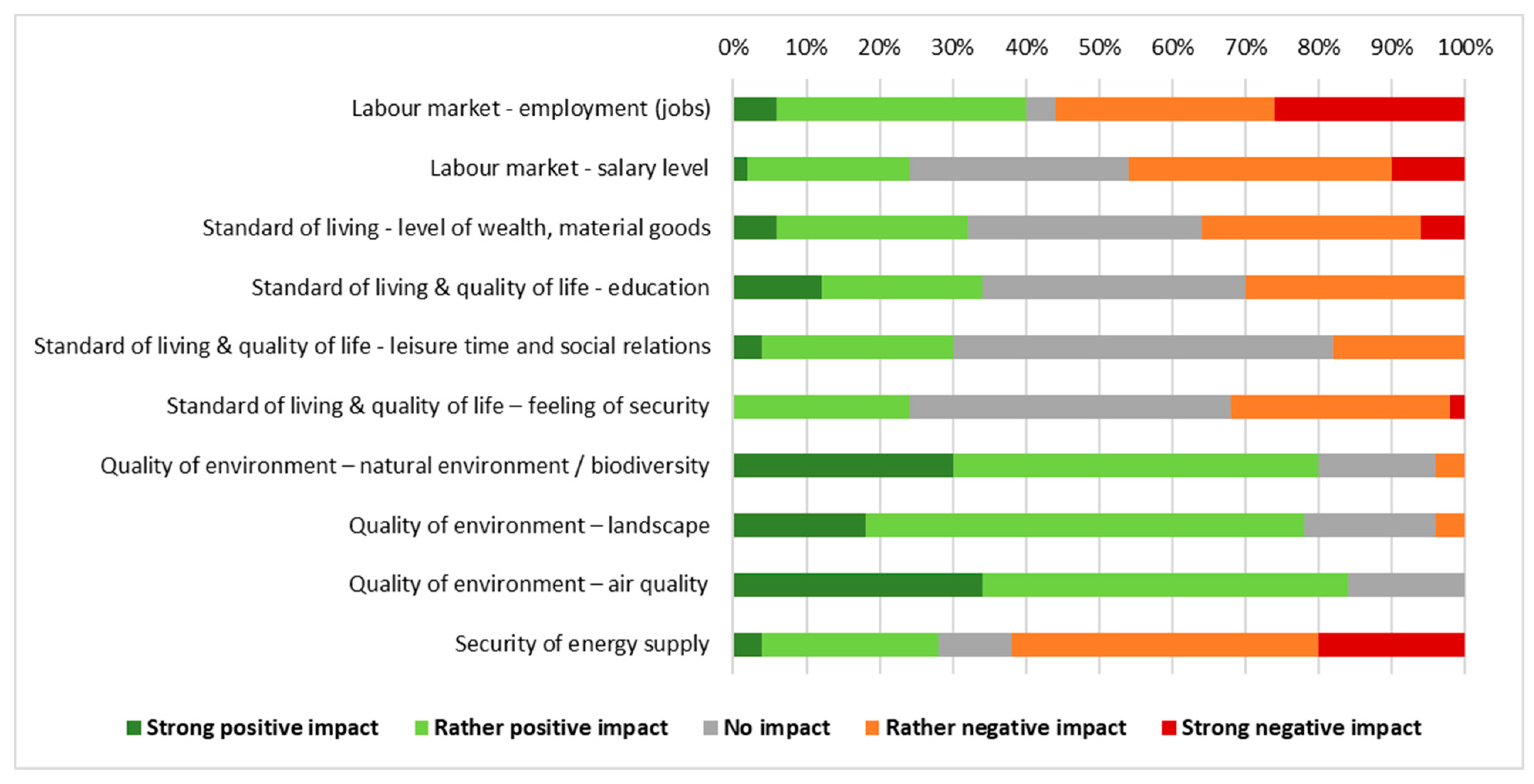
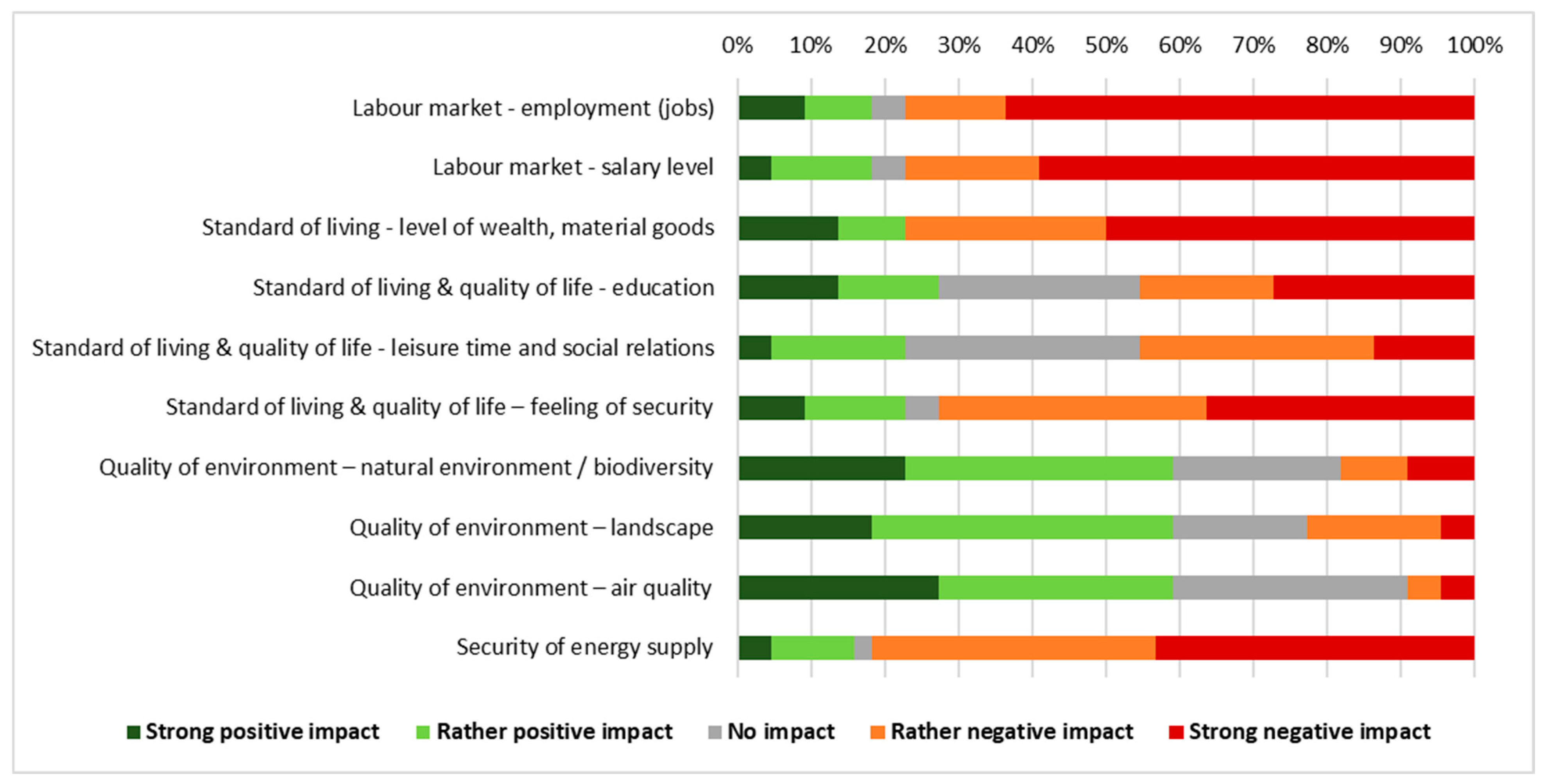
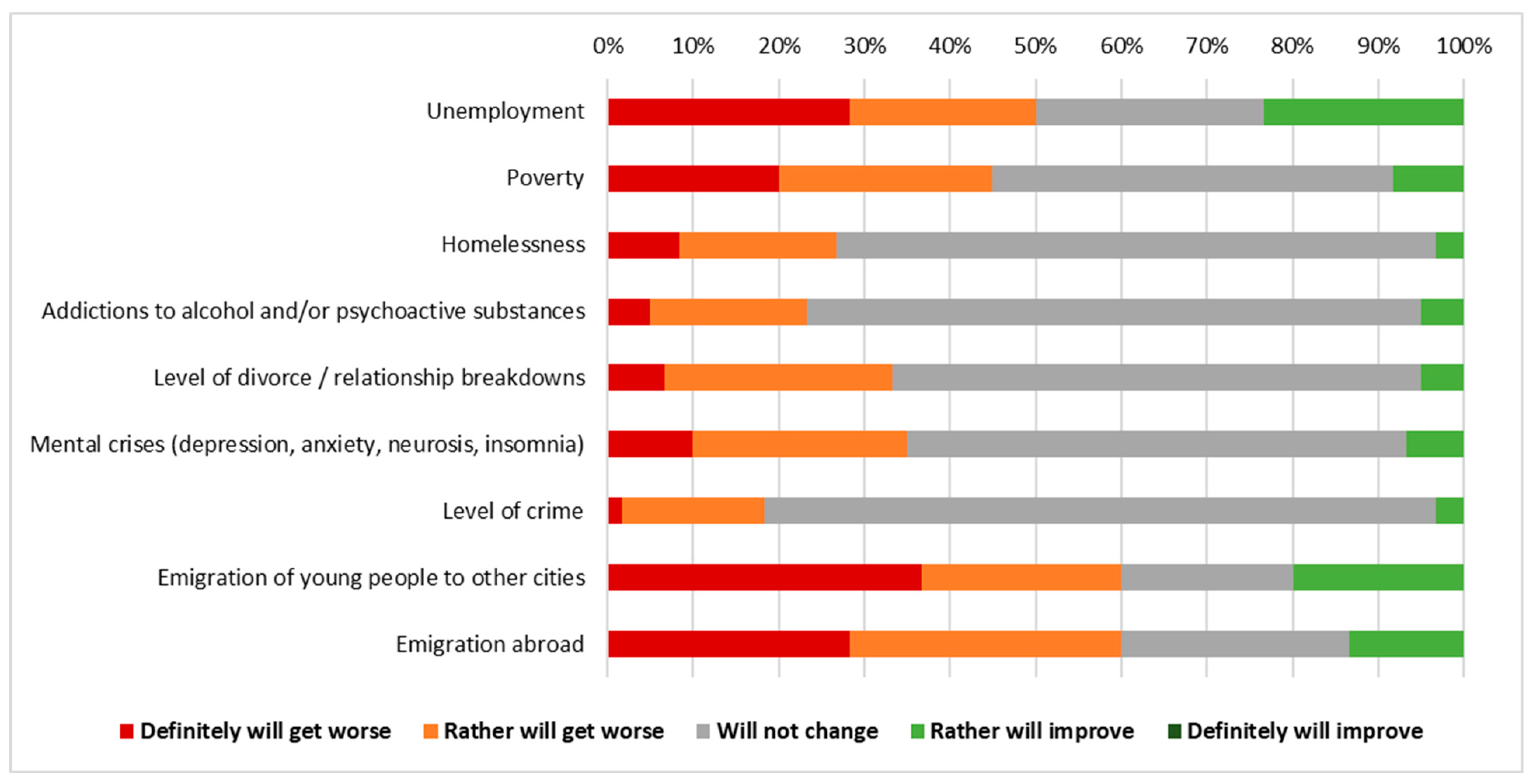
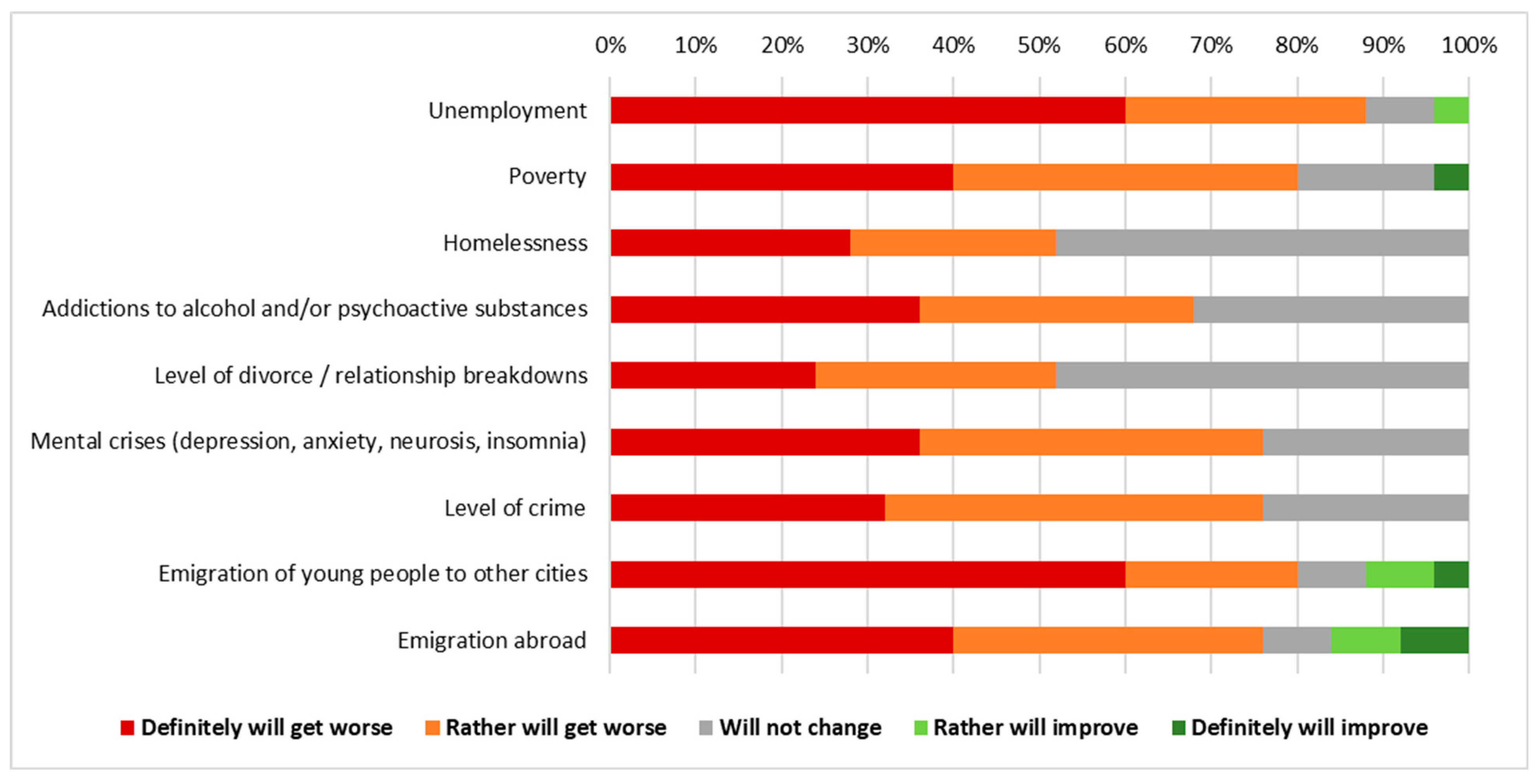
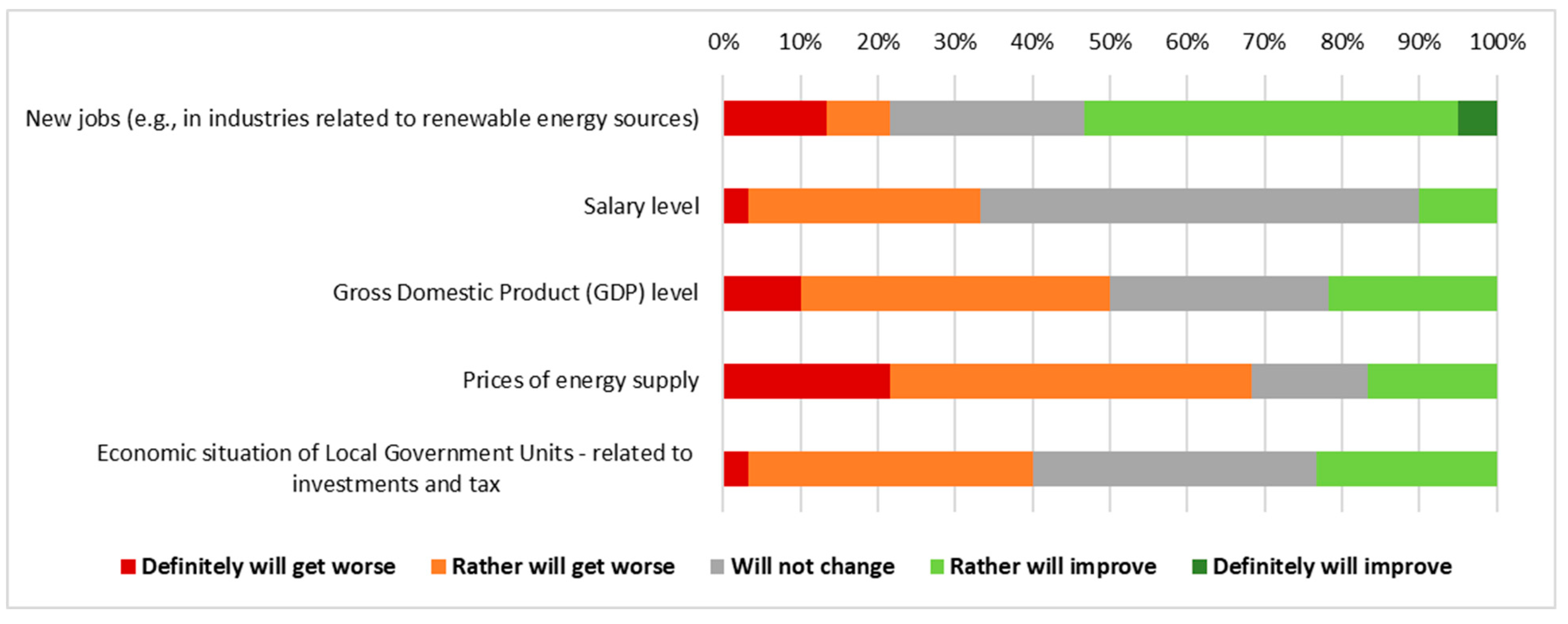
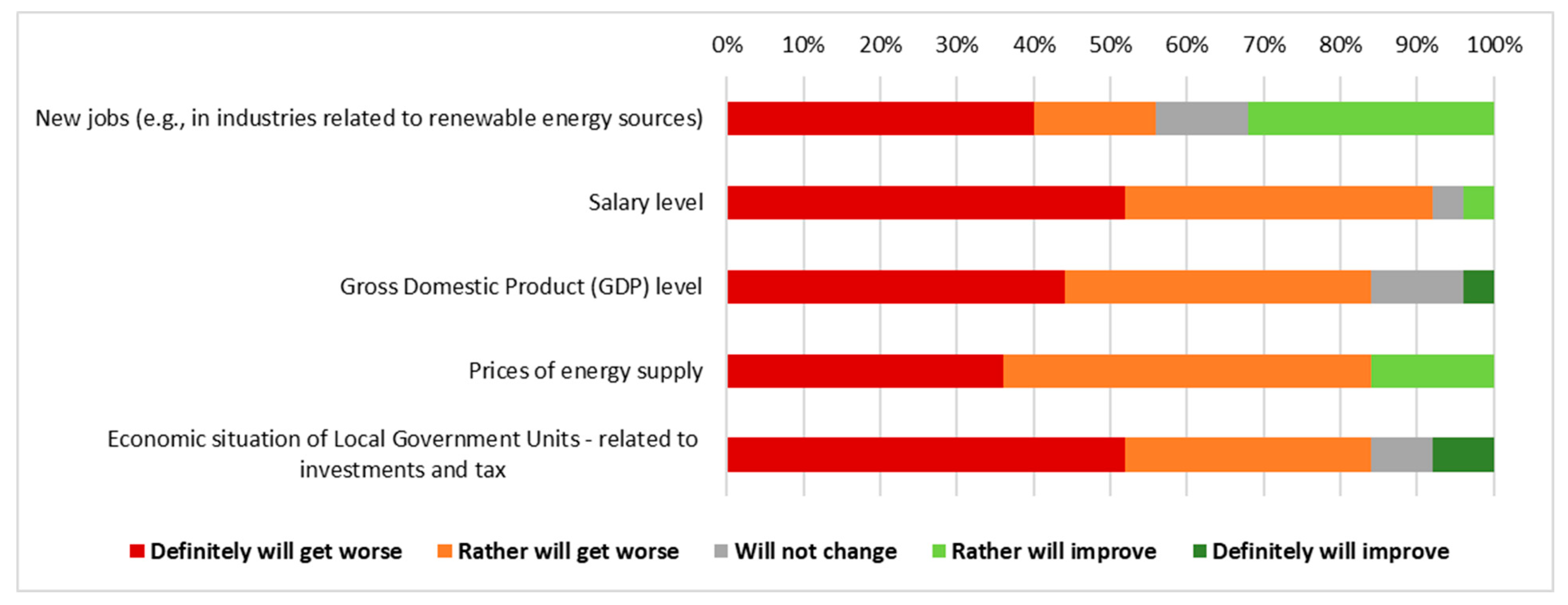
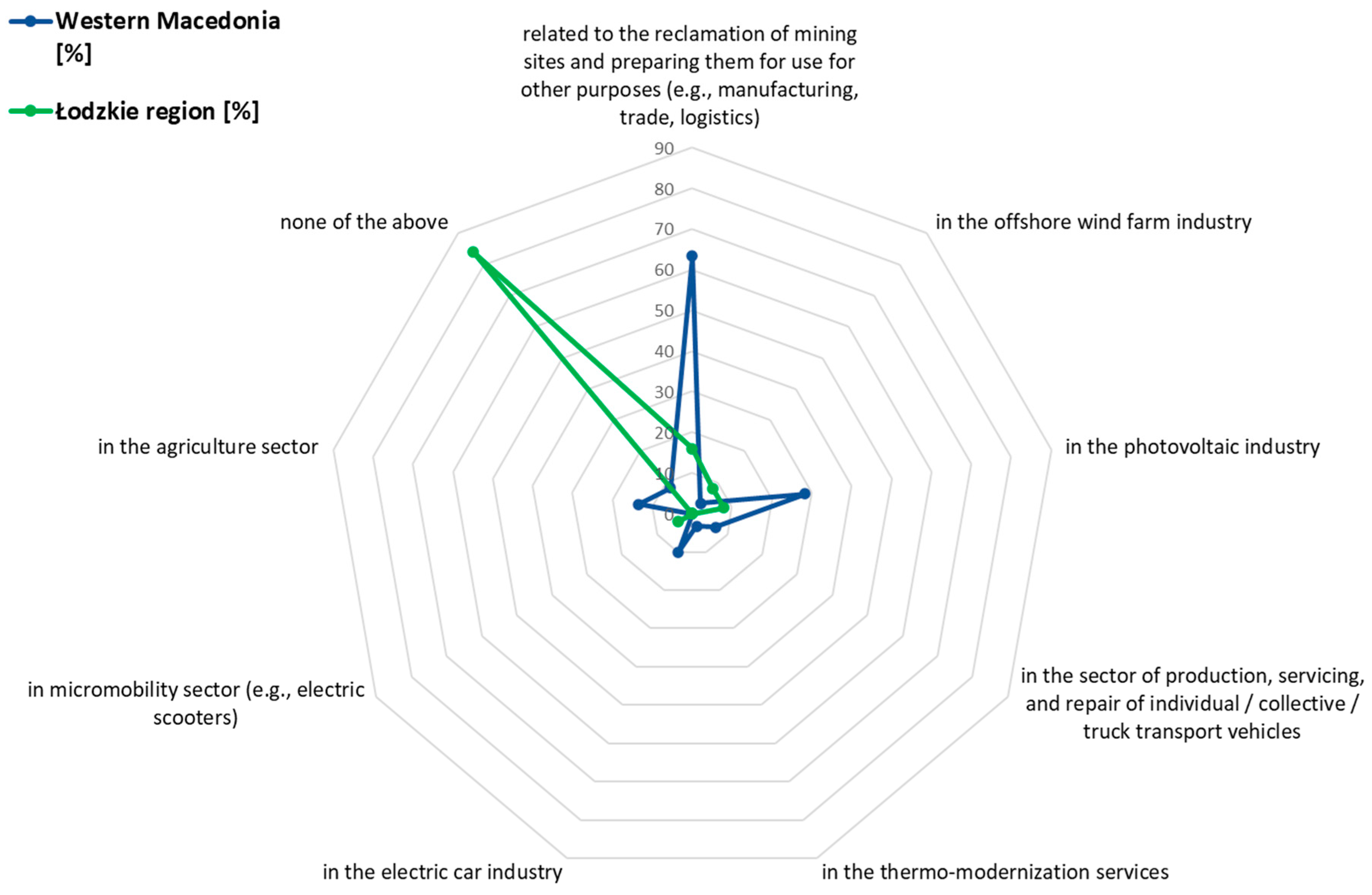

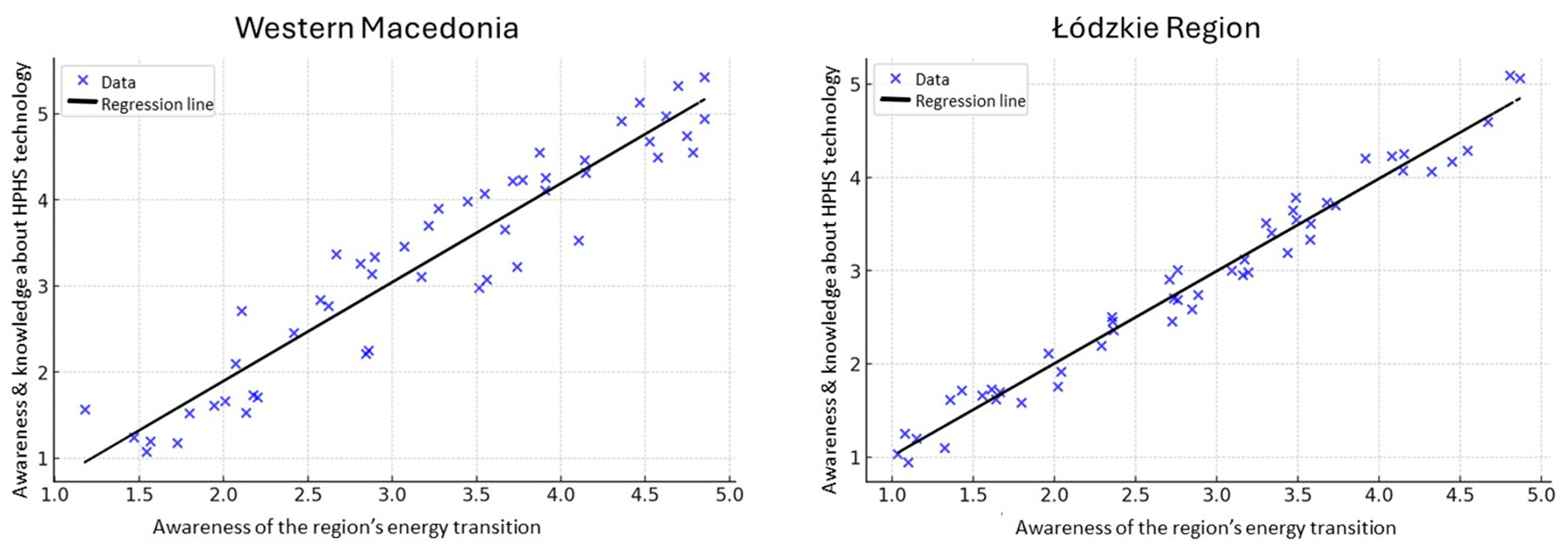
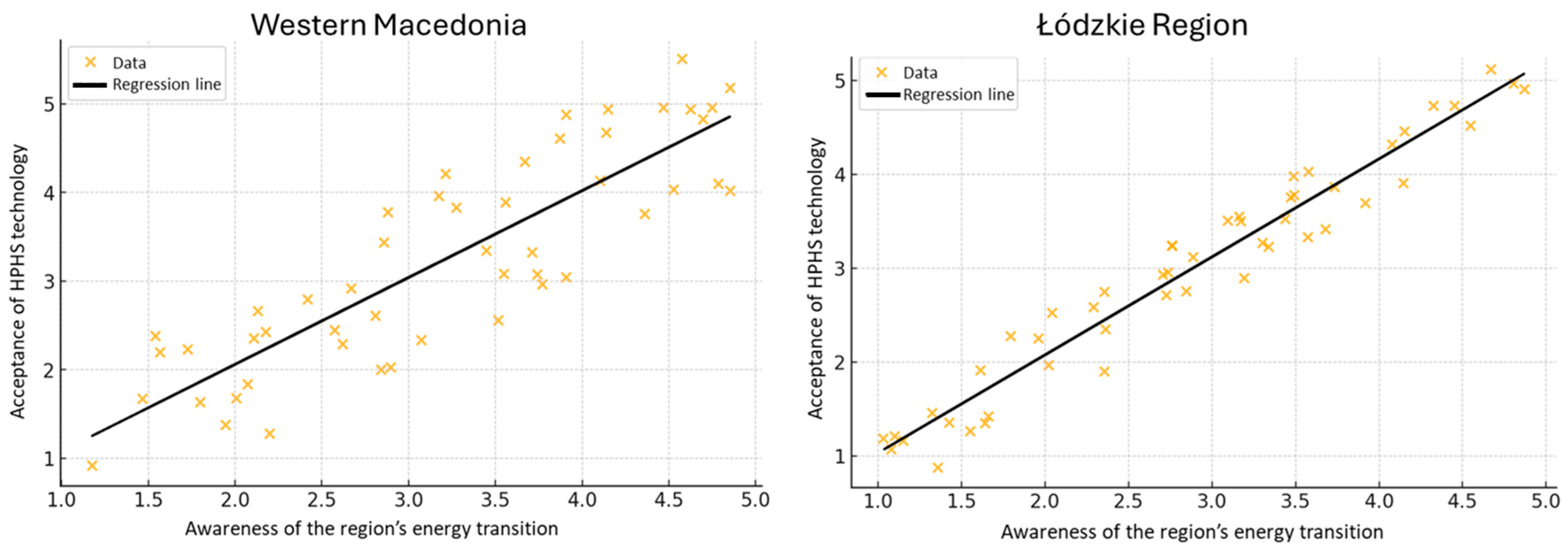
| Łódzkie Region (%) | Western Macedonia (%) | Respondents Characteristic/Variables |
|---|---|---|
| Gender | ||
| 48.39 | 43.28 | Female |
| 45.16 | 52.24 | Male |
| 0.00 | 0.00 | Non-binary |
| 6.45 | 4.48 | I do not want to answer this question |
| Age | ||
| 13.33 | 8.96 | 18–29 years old |
| 33.33 | 49.25 | 30–44 years old |
| 46.67 | 34.33 | 45–59 years old |
| 6.67 | 7.46 | 60 years old and over |
| Education level | ||
| 3.33 | 0.00 | Elementary and junior high school |
| 0.00 | 1.49 | Basic vocational/professional (School of Industry of the first degree, basic vocational school) |
| 3.33 | 0.00 | Secondary vocational/professional/technical (Technical school, secondary vocational school) |
| 6.67 | 2.99 | Secondary general education |
| 0.00 | 4.48 | Post-secondary (non-tertiary) |
| 86.67 | 91.04 | Higher |
| Professional status | ||
| 3.33 | 4.48 | Student |
| 90.00 | 89.55 | Employed |
| 6.67 | 4.48 | Pensioner |
| 0.00 | 0.00 | Unemployed |
| 0.00 | 1.49 | Other |
| M | Me | SD | Sk. | Kurt. | Min | Max | |
|---|---|---|---|---|---|---|---|
| X1 | 1.89 | 2.0 | 0.31 | −2.59 | 4.69 | 1.00 | 2.00 |
| X2 | 3.86 | 4.0 | 1.11 | −0.99 | 0.26 | 1.00 | 5.00 |
| X3 | 1.76 | 2.0 | 0.43 | −1.23 | −0.50 | 1.00 | 2.00 |
| Y1 | 4.21 | 5.0 | 0.99 | −0.99 | 0.16 | 1.00 | 5.00 |
| M | Me | SD | Sk. | Kurt. | Min | Max | |
|---|---|---|---|---|---|---|---|
| X1 | 1.81 | 2.0 | 0.39 | −1.55 | 0.41 | 1.00 | 2.00 |
| X2 | 4.16 | 5.0 | 1.06 | −0.85 | −0.75 | 1.00 | 5.00 |
| X3 | 1.48 | 2.0 | 0.50 | 0.06 | −1.99 | 1.00 | 2.00 |
| Y1 | 3.68 | 4.0 | 1.13 | −0.86 | 0.08 | 1.00 | 5.00 |
| X1 | X2 | X3 | Y1 | |
|---|---|---|---|---|
| X1. Energy transition awareness | 1 | |||
| X2. Perceived direct impact of the energy transition process on repondent’s life | 0.2676 * | 1 | ||
| X3. HPHS knowledge | 0.3809 * | 0.0903 | 1 | |
| Y1. HPHS support and acceptance | 0.3200 * | 0.1491 | 0.8292 ** | 1 |
| X1 | X2 | X3 | Y1 | |
|---|---|---|---|---|
| X1. Energy transition awareness | 1 | |||
| X2. Perceived direct impact of the energy transition process on repondent’s life | 0.5417 ** | 1 | ||
| X3. HPHS knowledge | 0.4743 ** | 0.4045 * | 1 | |
| Y1. HPHS support and acceptance | 0.4428 ** | 0.2640 * | 0.5679 ** | 1 |
Disclaimer/Publisher’s Note: The statements, opinions and data contained in all publications are solely those of the individual author(s) and contributor(s) and not of MDPI and/or the editor(s). MDPI and/or the editor(s) disclaim responsibility for any injury to people or property resulting from any ideas, methods, instructions or products referred to in the content. |
© 2025 by the authors. Licensee MDPI, Basel, Switzerland. This article is an open access article distributed under the terms and conditions of the Creative Commons Attribution (CC BY) license (https://creativecommons.org/licenses/by/4.0/).
Share and Cite
Kruczek, M.; Markowska, M.; Servou, A.; Roumpos, C.; Mertiri, E.; Ernst, P.; Darmosz, J.; Kempka, T. Navigating Socio-Technical Challenges in Energy Efficiency: Case Studies on Hybrid Pumped-Hydropower Storage in Poland and Greece. Energies 2025, 18, 599. https://doi.org/10.3390/en18030599
Kruczek M, Markowska M, Servou A, Roumpos C, Mertiri E, Ernst P, Darmosz J, Kempka T. Navigating Socio-Technical Challenges in Energy Efficiency: Case Studies on Hybrid Pumped-Hydropower Storage in Poland and Greece. Energies. 2025; 18(3):599. https://doi.org/10.3390/en18030599
Chicago/Turabian StyleKruczek, Mariusz, Malgorzata Markowska, Aikaterini Servou, Christos Roumpos, Eleni Mertiri, Priscilla Ernst, Jaroslaw Darmosz, and Thomas Kempka. 2025. "Navigating Socio-Technical Challenges in Energy Efficiency: Case Studies on Hybrid Pumped-Hydropower Storage in Poland and Greece" Energies 18, no. 3: 599. https://doi.org/10.3390/en18030599
APA StyleKruczek, M., Markowska, M., Servou, A., Roumpos, C., Mertiri, E., Ernst, P., Darmosz, J., & Kempka, T. (2025). Navigating Socio-Technical Challenges in Energy Efficiency: Case Studies on Hybrid Pumped-Hydropower Storage in Poland and Greece. Energies, 18(3), 599. https://doi.org/10.3390/en18030599









